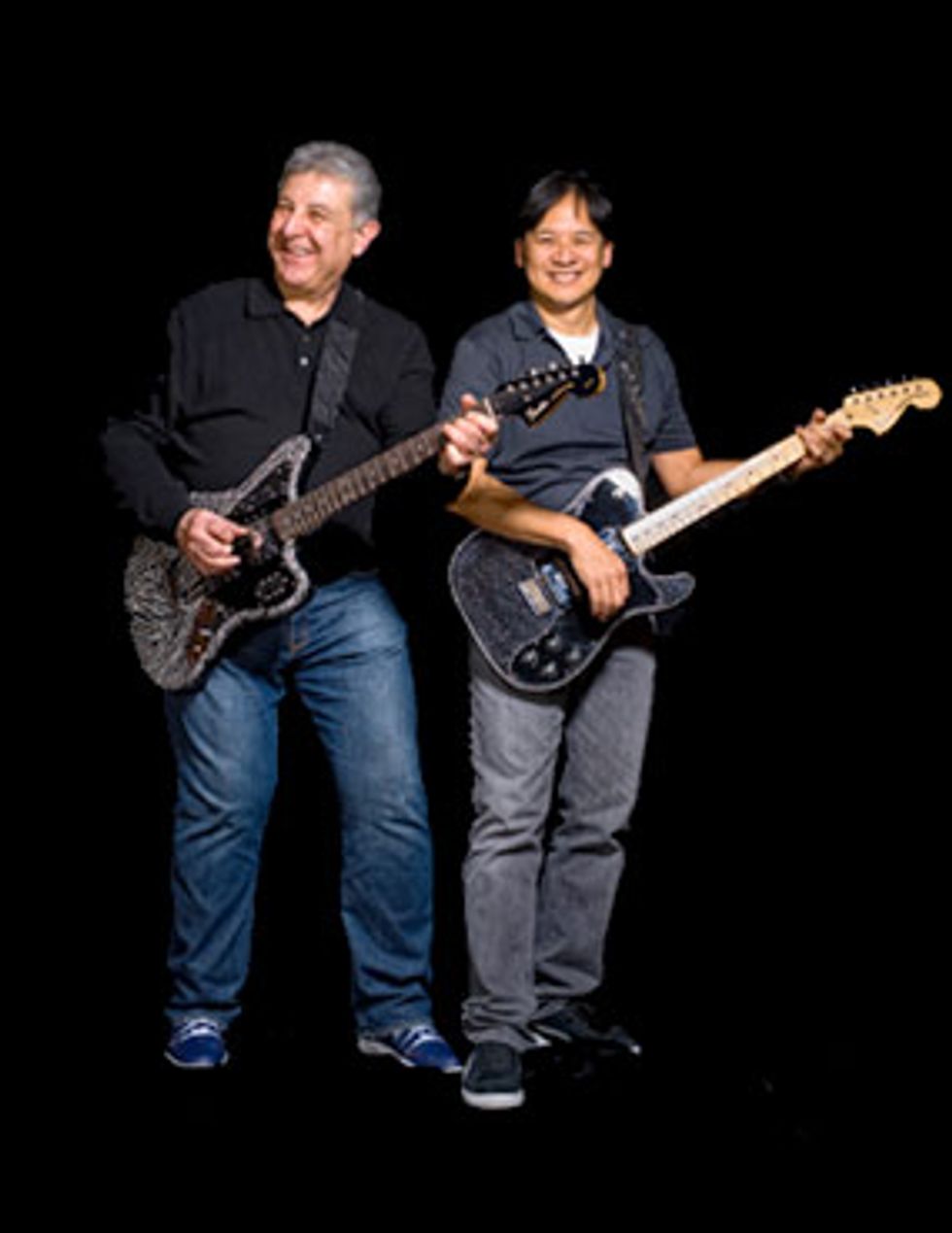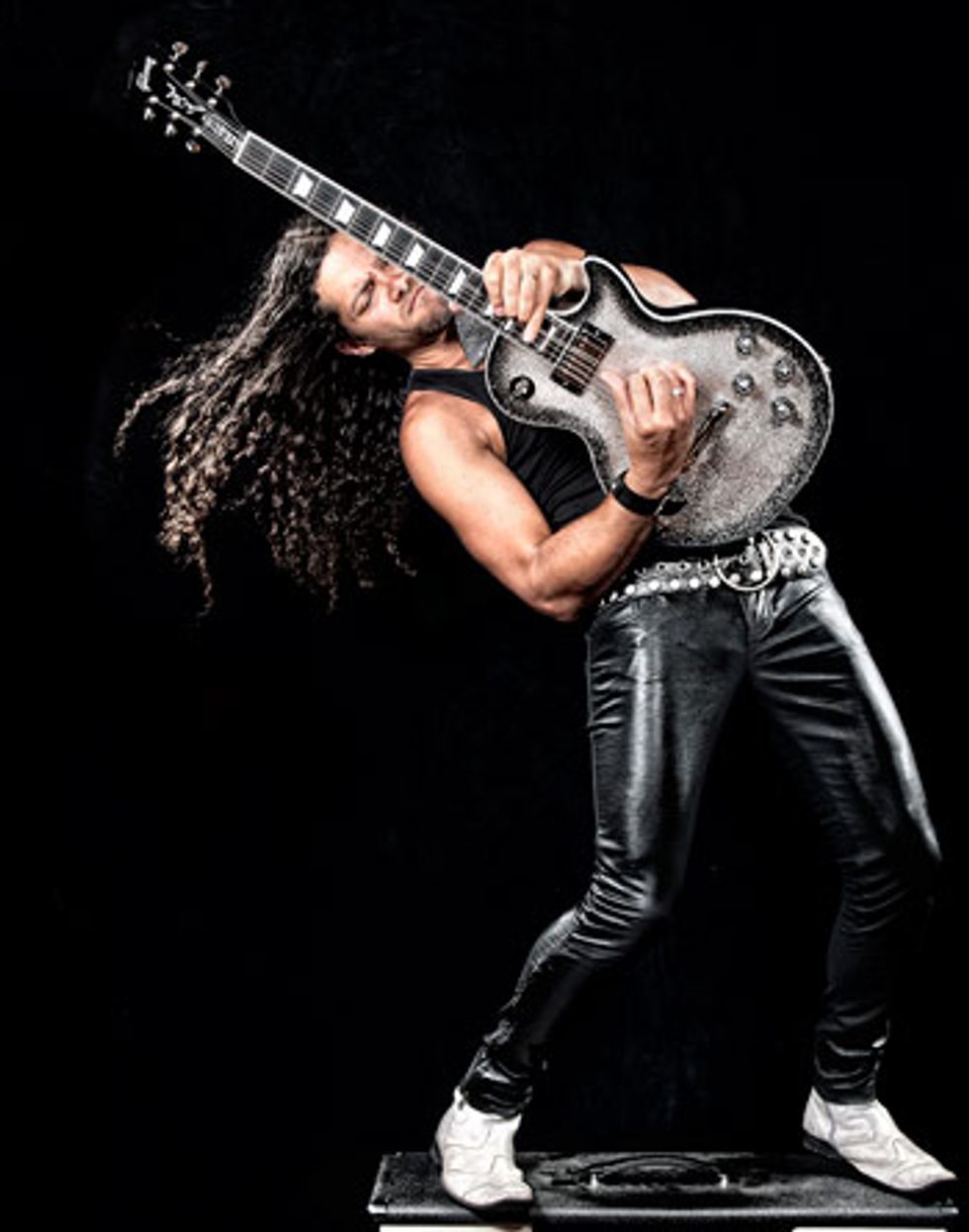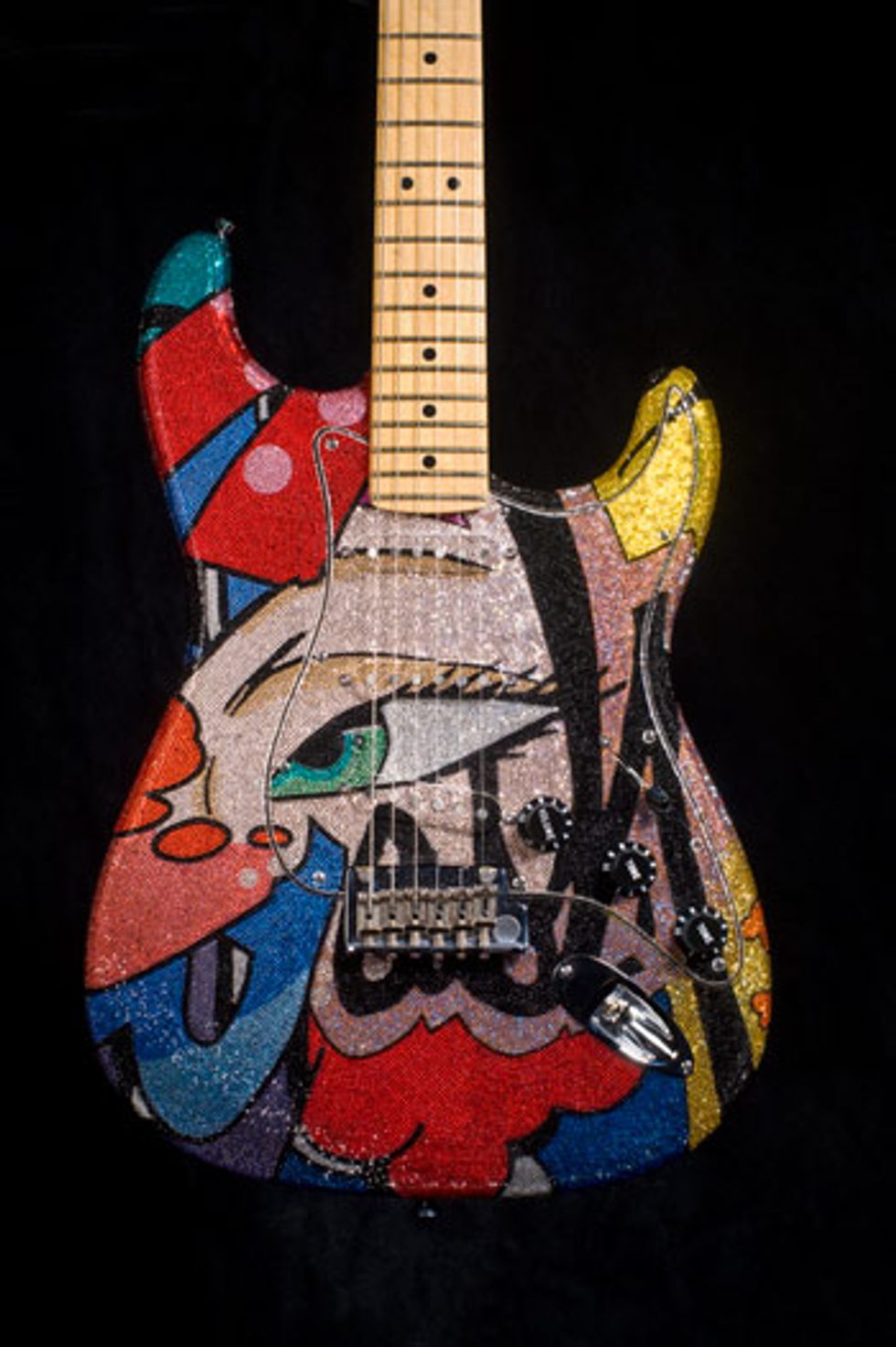| Click here to see a photo gallery of Kantor's Swarovski instruments ans some custom guitars from his collection. |
 Robert Kantor (right) and Rudy Pensa (left) holding two of Kantor's Swarovski guitars. |
Rudy Pensa has been a friend of mine since 1978. I started, like everyone else did with Rudy, as a customer. He opened a beautiful store in SoHo, and he started showing me the work of a sculptor named Hannibal (the line of guitars is AM). The idea of art and guitars came up, and I'd been working on some ideas, and he said, "You know, you ought to just try a couple of things. I'll put it in the store and we'll see what happens." So it was just something I tried, and it worked successfully. I had a vision and was fortunate enough to have the wherewithal to just execute it on my own.
So tell us about the Kantor guitars, what do you use as a base?
I've been Fender American Standard Stratocasters or Telecasters, which stems back to my work with Crash [Matos]. It's probably not a well-known fact that Eric Clapton actually utilizes American Standard stuff. The Crash guitars that he utilized over the years in his concerts were actually American Standard Strats.
How does the design process work?
Basically I come up with a concept and work with the artists at the factory to make a pattern. For example, if I'm going to do skulls, we'll make them like it was sort of a wallpaper pattern, then I fit the scale based on the scale of the actual artwork and what can physically be done with the stones.
I try to use the smallest stones to give it much more of a refined kind of look. I was at a concert recently seeing one of my clients playing, and using the smaller stones made it so it wasn't so reflective that it was obnoxious—it looked exactly how I envisioned it.
That’s Lady Gaga’s guitarist, Kareem Devin you’re referring to?
Yes, we’re working on a couple more instruments for Kareem that will be showing up on tour, and a few others in process that I can’t discuss yet. We’re experimenting, and it’s a lot of fun.

Kareem Devin with his custom Kantor Guitar
With the guitars being used on major tours, you must not consider them totally “art guitars.”
They’re completely player guitars. They're set up properly and have the proper types of pickup configurations and electronics, based on whatever one would normally play. They’re 100 percent playable, and there's no effect to the sound in a negative way.
Tell us about the actual stone application.
The actual stonework is done by a factory in New York City that puts every single stone on by hand using a tweezer. Two or three ladies work on the instruments, and it takes about a week, each instrument, to complete. The artwork is transposed and painted onto the body of the guitar and from there they stone the colors according to how we lay it out.
The stones cause no problems with the instruments in terms of their playability and durability. If something's out there on tour being banged around every day, worst case scenario they send it back to me and in one day it's turned around because the instruments are guaranteed for life if anything happens to them stone-wise.
How many instruments do you have for sale right now, and what’s the price range?
We have about a dozen instruments. They run anywhere from $10k to $25k retail.
Fender®, Stratocaster®, Telecaster®, and the distinctive headstock designs commonly found on these guitars are registered trademarks of Fender Musical Instruments Corporation. All rights reserved.
 One of Kantor's Swarovski collaborations with John "Crash" Matos entitled "Black" |
Crash and I met when just prior to Clapton auctioning off one of his instruments for his Crossroads drug rehab center. I approached Crash about getting one of his guitars in my collection, and he said Clapton had to grant permission. I persisted, and eventually he made me an instrument. I have a Gibson SG that Crash did for me that’s the only Gibson he’s ever done.
I saw that in the photos of your collection—how long have you been collecting?
This is sort of the second go-around for my collection. I originally collected '59 Les Pauls, '54-'56 Strats—those types of things. Unfortunately in my divorce I lost a tremendous amount of those things, and so beginning around 2000 I began collecting again. I thought this time what I would do is approach it differently, and somehow create vintage things in the future instead of having things that need to be hermetically sealed in a case where God forbid it's not exactly 50% humidity and you can't touch them or take them anywhere.
So for a few years I would go down to Gibson for two weeks every summer and create what I would call “What If” guitars. If I felt there was an instrument they should've made in 1969, I would configure it. In those days, the early 2000s, they still had a real custom shop where you could go down and you could really do whatever you wanted.
Do you have any favorites from this collection?
I think one of the ones I like the most is a piece by Bruce Kunkel [one of the head luthiers at the Gibson Custom Shop at the time] that’s a black Les Paul with gun metal finished parts. That came about when [Gibson CEO] Henry Juskiewicz told Bruce to envision what it would look like if they were to take the Les Paul into the future. He sculpted a few of these pieces and I'm fortunate to have one—I think there were only six ever made.
Another one that was done by Bruce on his own is an acoustic that's made out of koa called the Spirit of New York. Each inlay is made out of pearl with a theme from New York City—it has the Brooklyn Bridge, the World Trade Centers, and the Statue of Liberty in the inlay. The neck heel is hand-carved like the Chrysler building. That's an amazing instrument.
I've also started to pick up things I call unloved guitars. I recently picked up a perfect condition Epiphone Scroll—I think it was probably the least-selling guitar ever made. It happens to be a really charming instrument. I also just picked up a Gibson Corvus. It's one of these kinds of things that nobody in their right mind ever wanted. You can go on forever about things you want to have that are part of a core collection, but it's great to go out there and have fun. As long as you play on it and love it, and you give it love, in the end it's going to be a great instrument. I don’t think you can look at guitars as “It's worth this amount of money and that's what makes it good.”
Has your focus shifted from collection to creating for the most part?
I have about 150 instruments, so what is enough? I think at a certain point it becomes a little too obscene. I do really believe in supporting smaller luthiers, though. One of the most recent things I purchased was one from AM, which has a marbleized look and is very sculpted. But, I'm mostly focusing on my projects now.
You’re open to commissions, right?
I would certainly consider anybody who has a reasonable idea that I think can be done to the satisfaction of the customer. Rudy handles all the commissions for me.
What’s next for Kantor Guitars?
I have two Telecasters [designed with Crash] that are waiting to be completed. There are more things that we are going to do, it's been successful, and it's something we just have fun doing together.
I also have ideas for using metal studs, and doing a series that is more motorcycle or machine-oriented. There are kind of endless amounts of things that you can apply to an instrument, it's just about keeping the level of the work at a high standard. I insist on things being absolutely perfect in the way they're executed, and I think that's why they're so stunning.














![Rig Rundown: AFI [2025]](https://www.premierguitar.com/media-library/youtube.jpg?id=62064741&width=1245&height=700&quality=70&coordinates=0%2C0%2C0%2C0)












 Shop Scott's Rig
Shop Scott's Rig